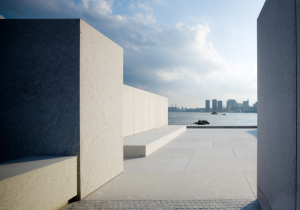
Photograph: Raymond Meier/Vanity Fair
Much has been written about the recently completed FDR Memorial in New York, designed by Louis Kahn. It was the great architect’s last project, and he had just completed it when he died in 1974, almost four decades ago. Kahn’s design reminds us how much has changed in forty years. First, the commission was not the result of a competition, no hoopla, no wowing the jury, no rush. Instead Kahn was given the time to ponder and reflect—which is how he worked, anyway. Second, although the site covers about three and a half acres on the tip of Roosevelt Island, the memorial itself is an open-air room, only sixty feet square; Kahn felt no need to spread over the entire site, treating the rest instead as a green forecourt. The room is close in spirit to the commemorative block of marble that FDR’s friends erected in front of the National Archives in Washington, DC. Third, the memorial is not only small in size, it is focused. A single quotation (the famous Four Freedoms speech) and the president’s name, are all the writing there is; no didactic explanations, no rhetoric, no wheel chair, no Fala. Fourth, Kahn recognized that a memorial to a person must include that person’s presence, here in the form of a bust by Jo Davidson. All important lessons for future memorial builders.

